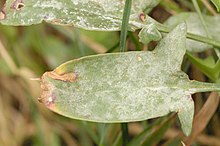Erysiphe betae
| Erysiphe betae | |
|---|---|
 |
|
| Scientific classification | |
| Kingdom: | Fungi |
| Phylum: | Ascomycota |
| Class: | Leotiomycetess |
| Subclass: | Leotiomycetidae |
| Order: | Erysiphales |
| Family: | Erysiphaceae |
| Genus: | Erysiphe |
| Species: | E. betae |
| Binomial name | |
|
Erysiphe betae (Vaňha) Weltzien, (1963) |
|
| Synonyms | |
|
Erysiphe communis f. betae |
|
Erysiphe communis f. betae
Erysiphe polygoni
Ischnochaeta polygoni
Microsphaera betae
Microsphaera polygoni
Erysiphe betae is a plant pathogen. It is a form of powdery mildew that affects sugar beet. It can cause up to a 30% yield loss. The fungus occurs worldwide in all regions where sugar beet is grown and it also infects other edible crops, e.g. beetroot.
This pathogen is a strict obligated parasite, and therefore can only be identified when in planta. Often to properly identify this pathogen some form of microscopic analysis is needed if only found on one type of plant. This can be done through isolation and observation of cleistothecia which are the product of sexual reproduction.
The pathogen survives through cleistothecia present in the crop debris in the field. These cleistothecia contain ascospores which can survive over winter inside of the enclosed cleistothecia. Infection occurs when ascospores or conidia are able to germinate and penetrate the plant's leaf. After infection, the pathogen, now a collection of hyphae, begins producing conidia on short conidiaphores. Both ascospores and conidia on a plant can be the source of a primary inuculum or "first infection". Conidia have been seen to travel long distances as a primary inuculum. The creation of cleistothecia ooccurs in limited regions as determined by weather conditions.
This fungus has a white powdery appearance. It appears on leaves in the summer time. Infection normally begins on older leaves, typically close to the junction between the lamina and petiole, and it develops on both ab- and adaxial surfaces.
This pathogen decreases yields in crops by the reduction of light to chlorophyll in the leaves of plants. This will affect (as was mentioned) the yield and the quality of the seed crops. It also causes leaf and shoot deformities. In the case of Erysiphe betae, entry into the cell is both mechanical penetration and enzymatic degradation of the cuticle and the cell wall.
The way that plants deal with these enzymes is they have an array of specialized inhibitors that counteract the effects of that specific pathogen. Some of these degrading enzymes include pectin lyases and polygalacturonases. In the case of when the pathogen gets entry through mechanical means the plant in itself doesn’t have much it can do against this kind of attack.
In the case of control against Erysiphe betae, not much is known about how to totally eradicate this disease once it has taken hold of your crop. It must therefore be assumed that the best method of control is prevention. Reducing the chances of this pathogen getting into your crop seems to be the best way of stopping this disease. This can be effectively done using fungicides. Some genes have been identified in wild species.
...
Wikipedia
